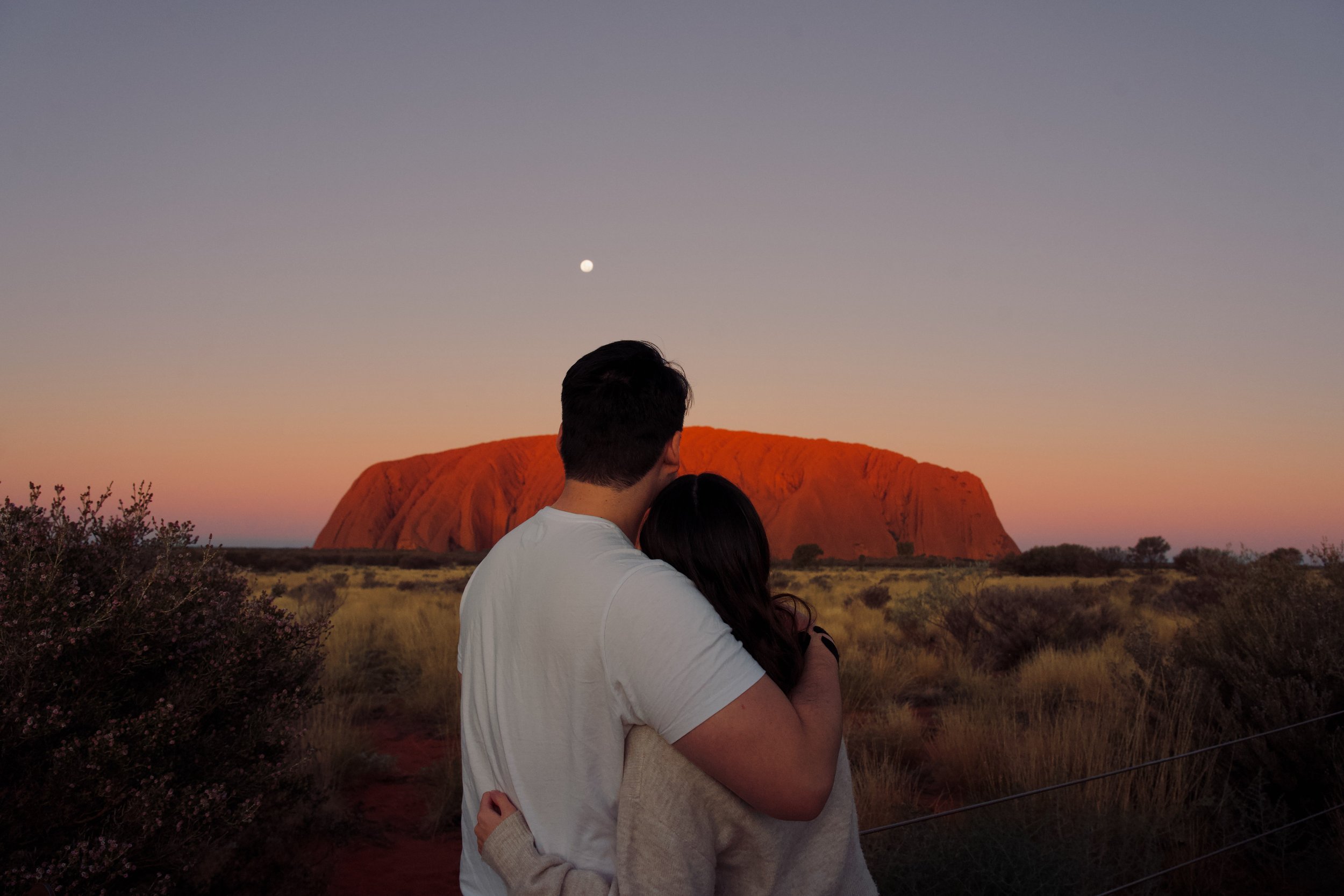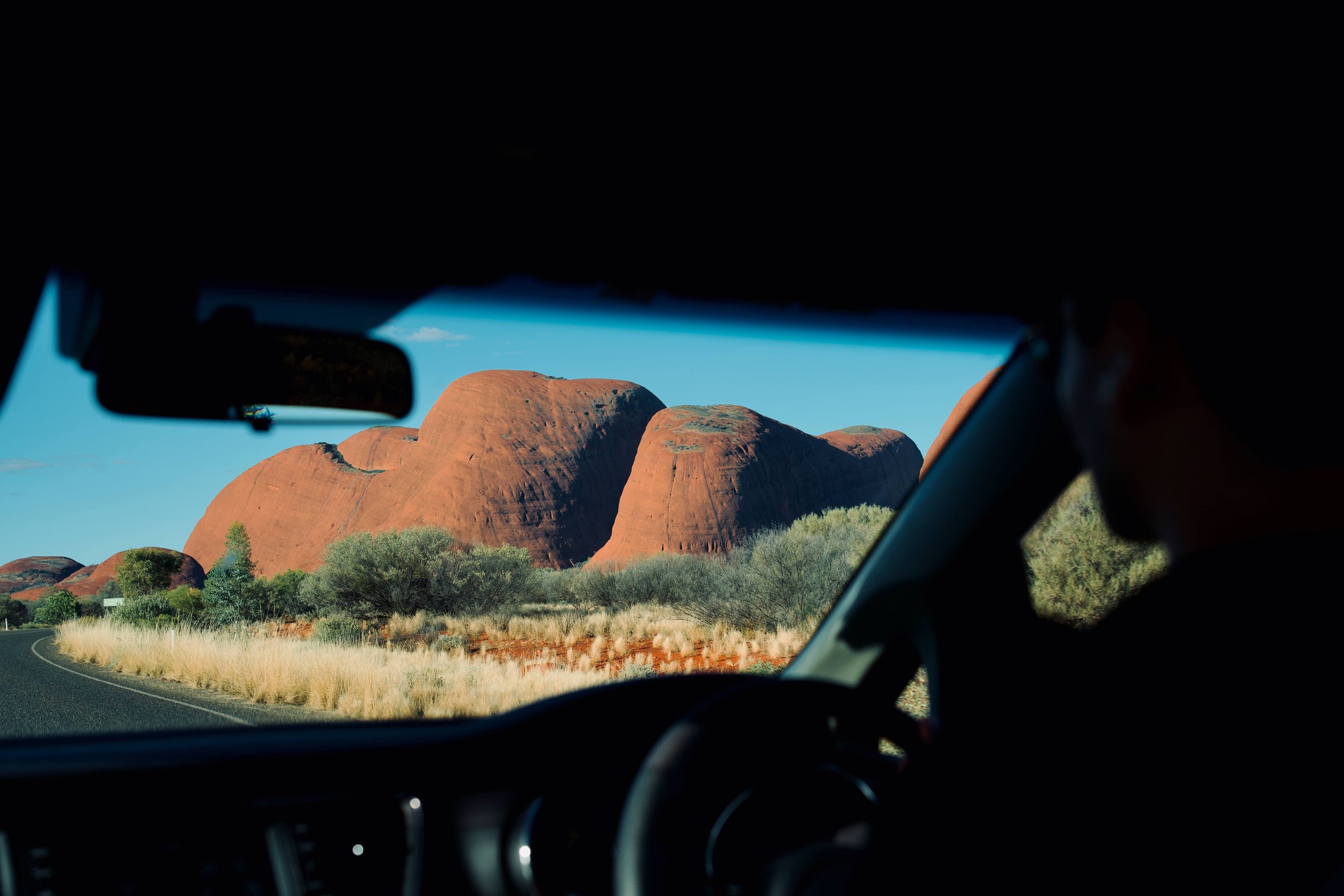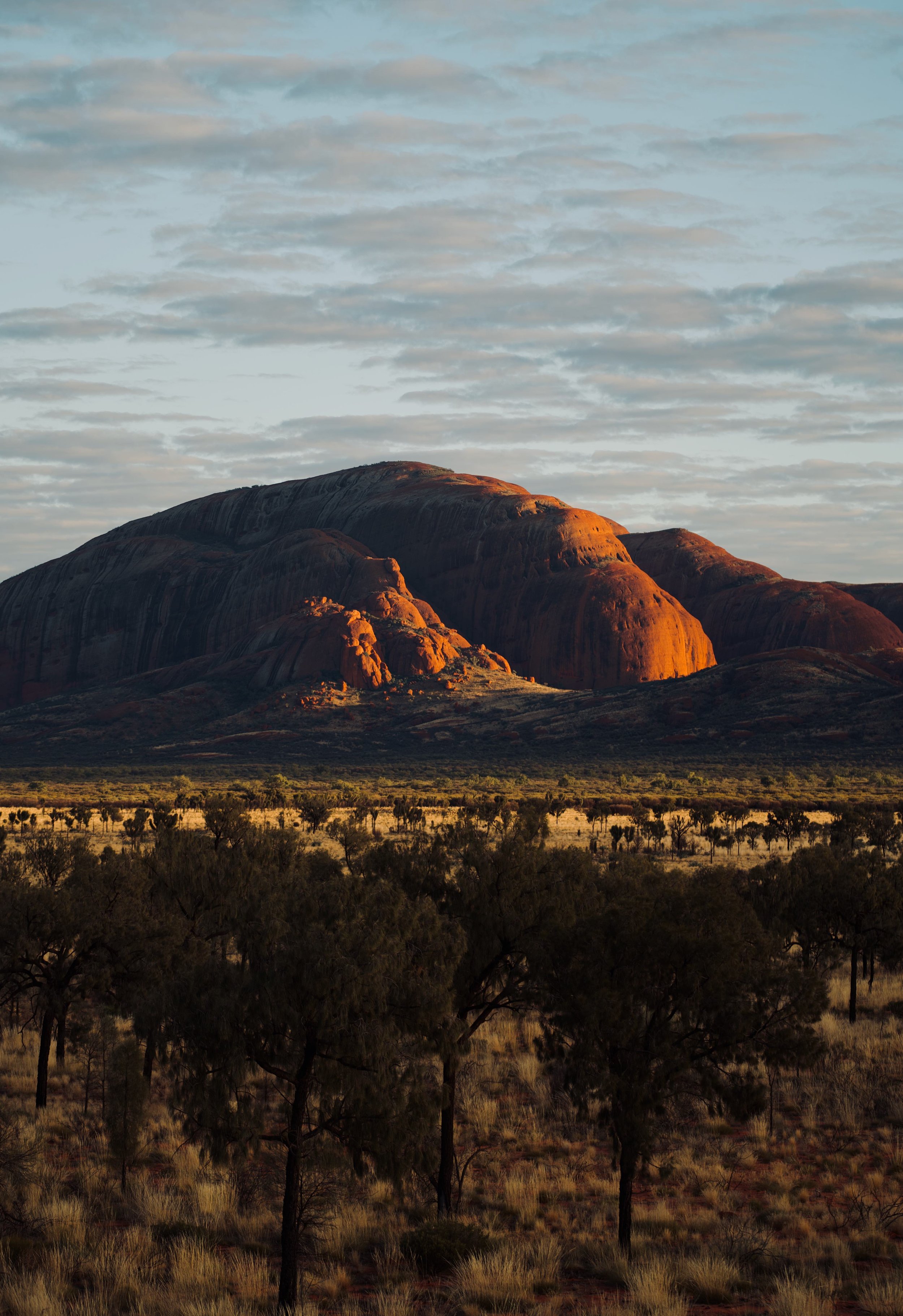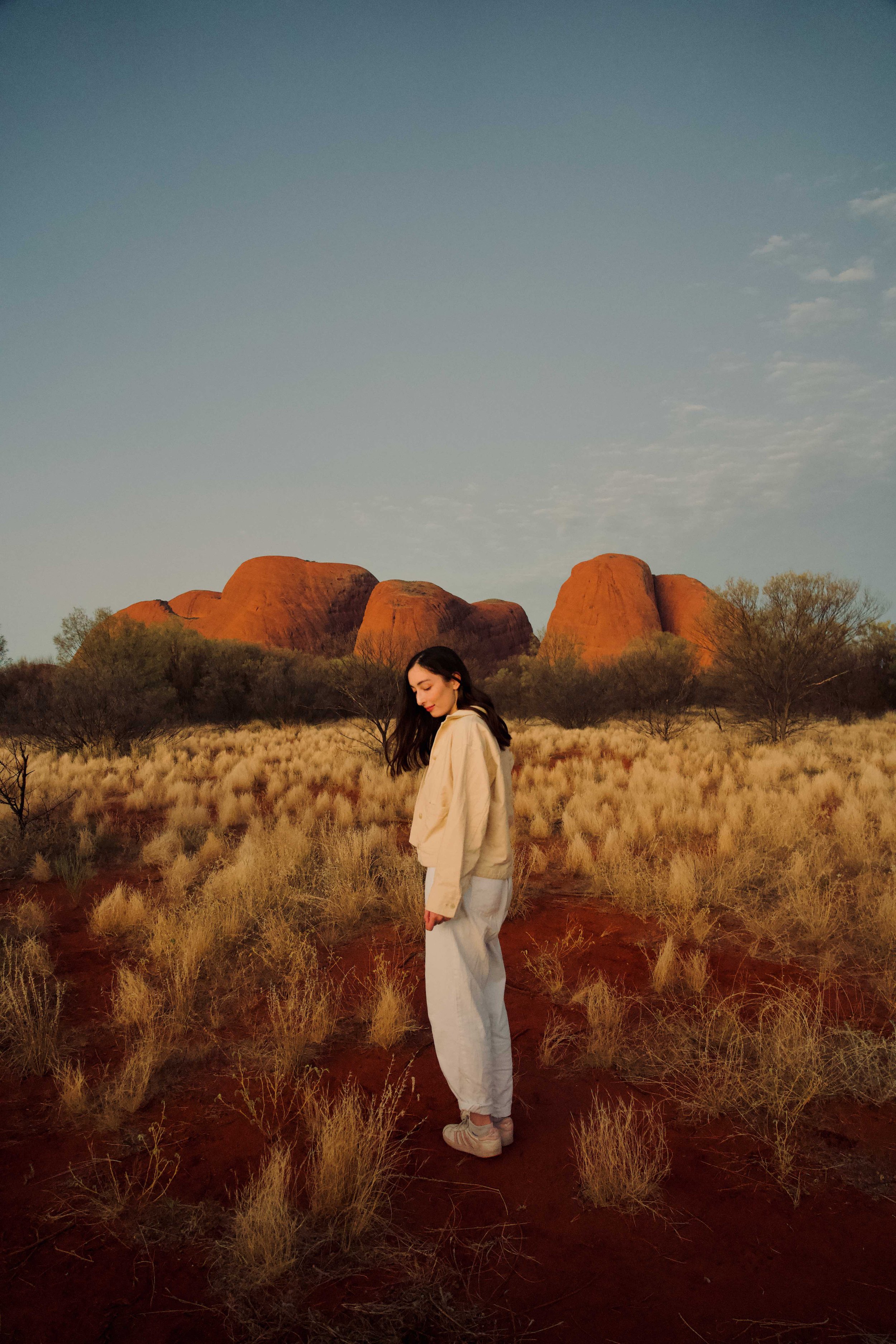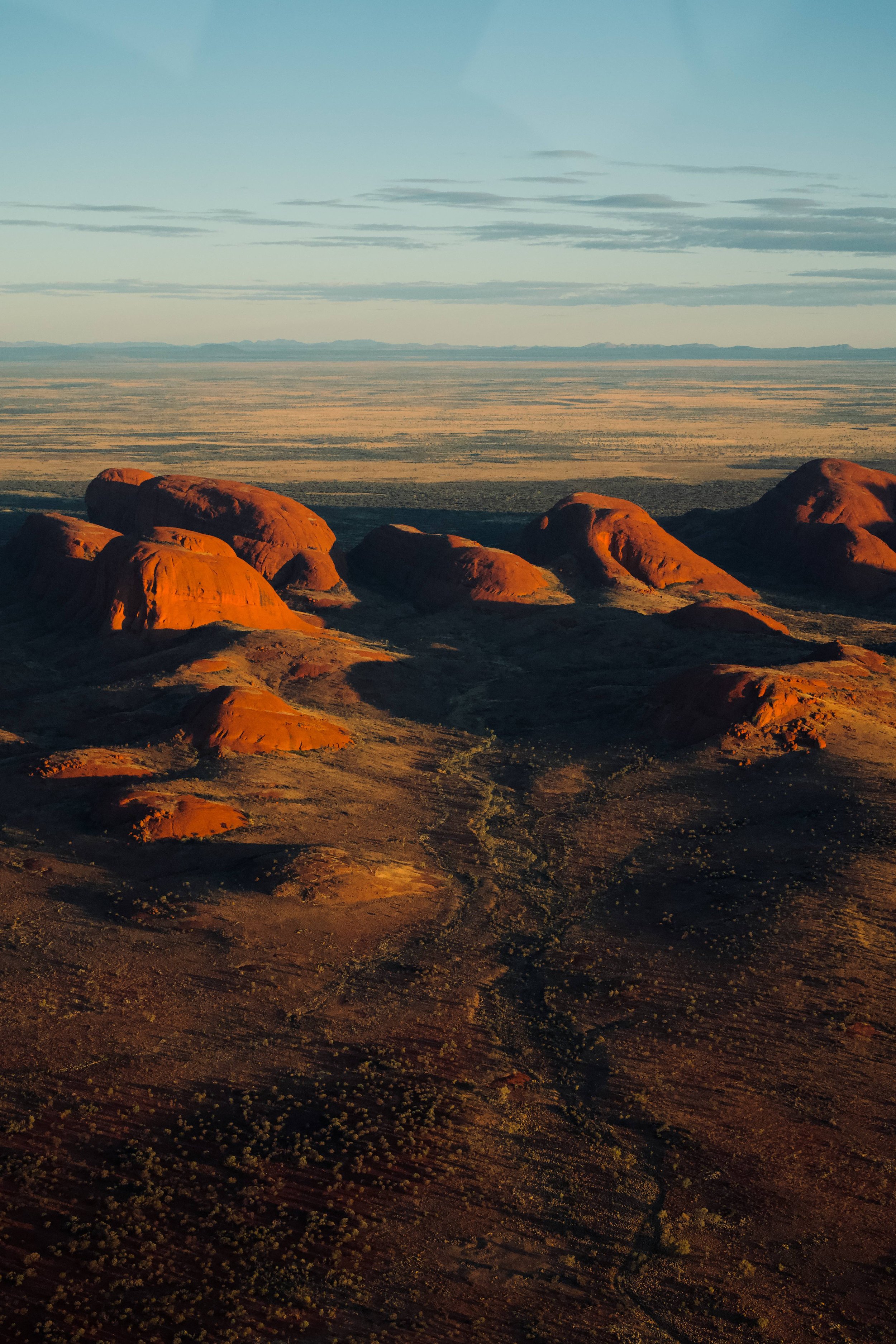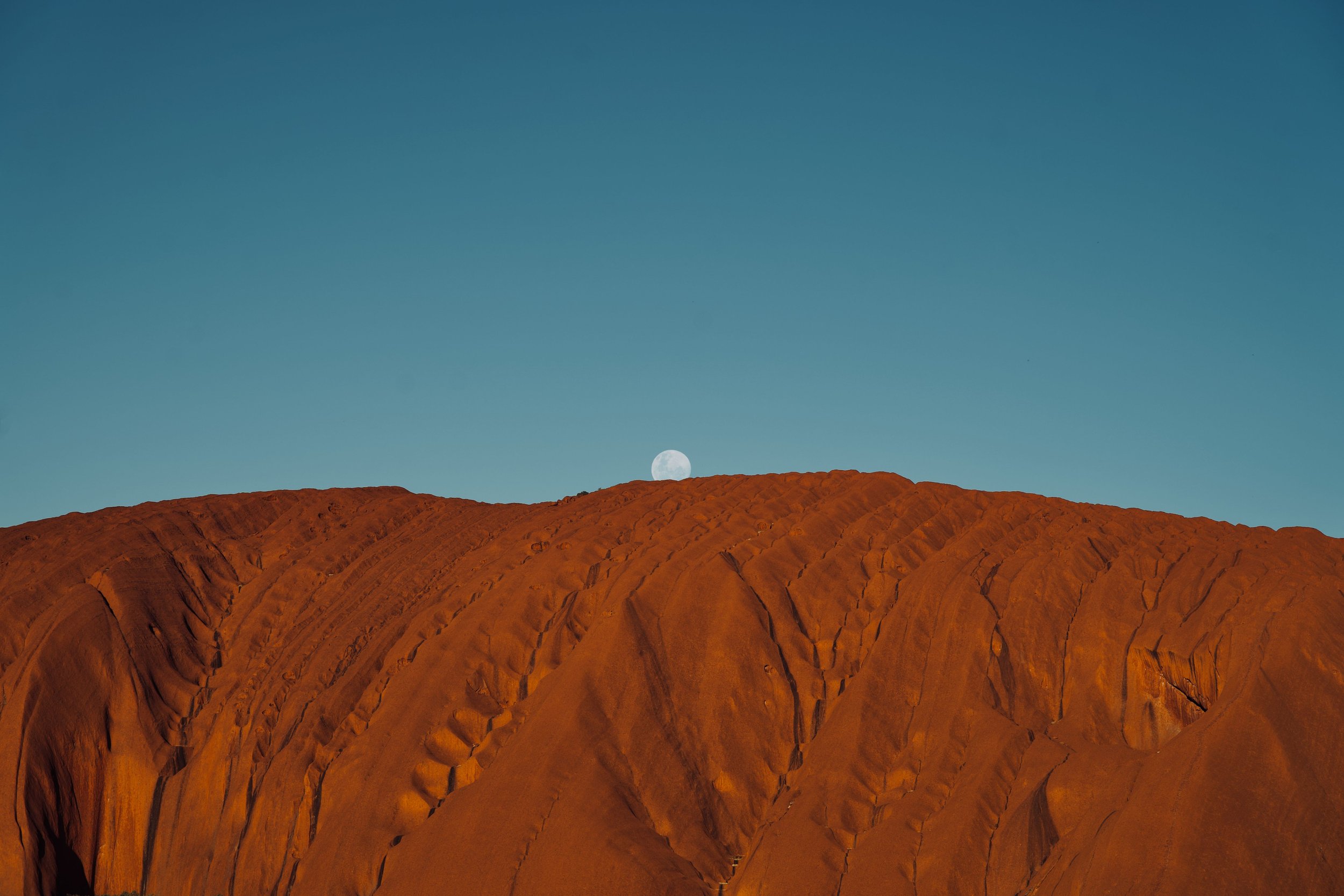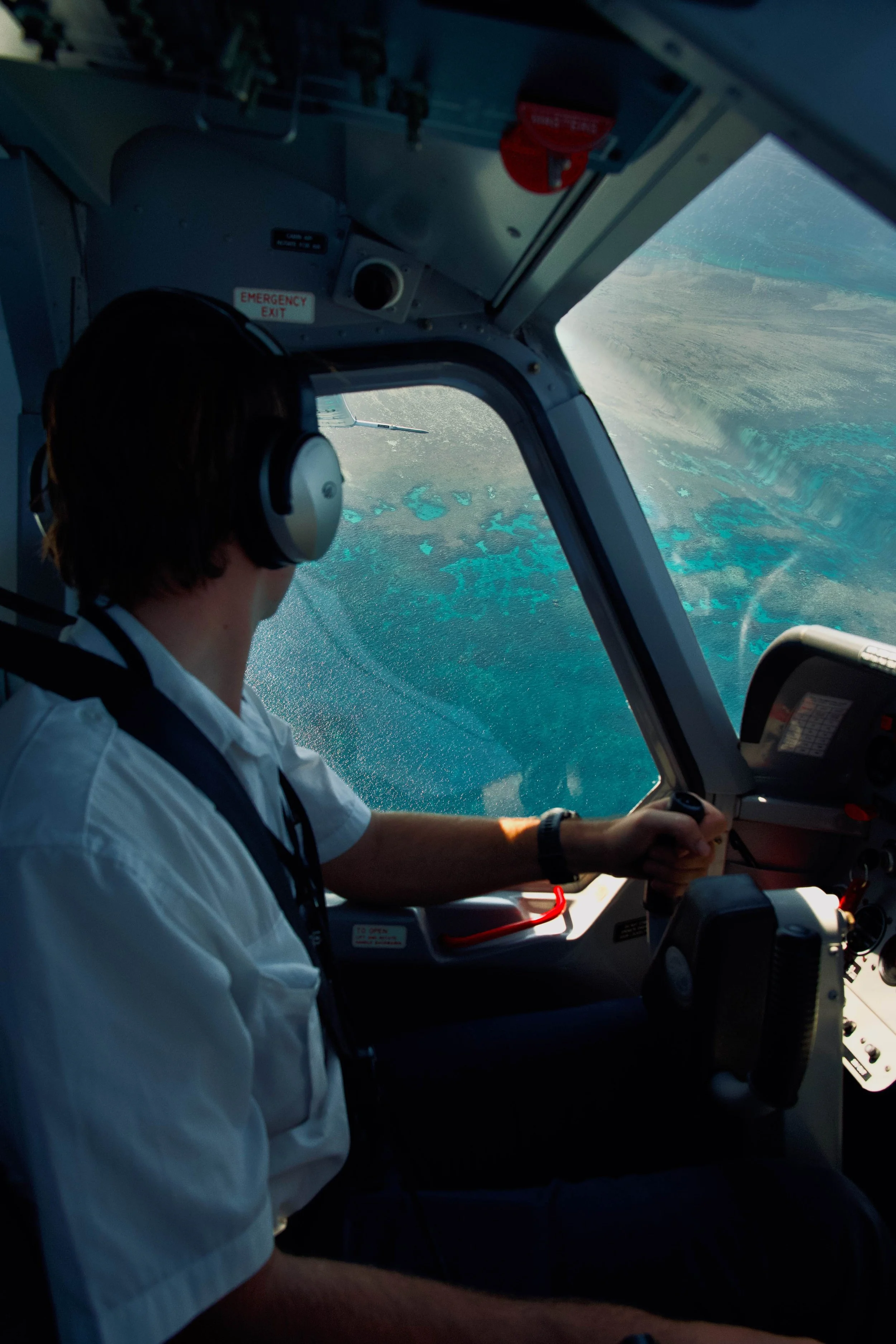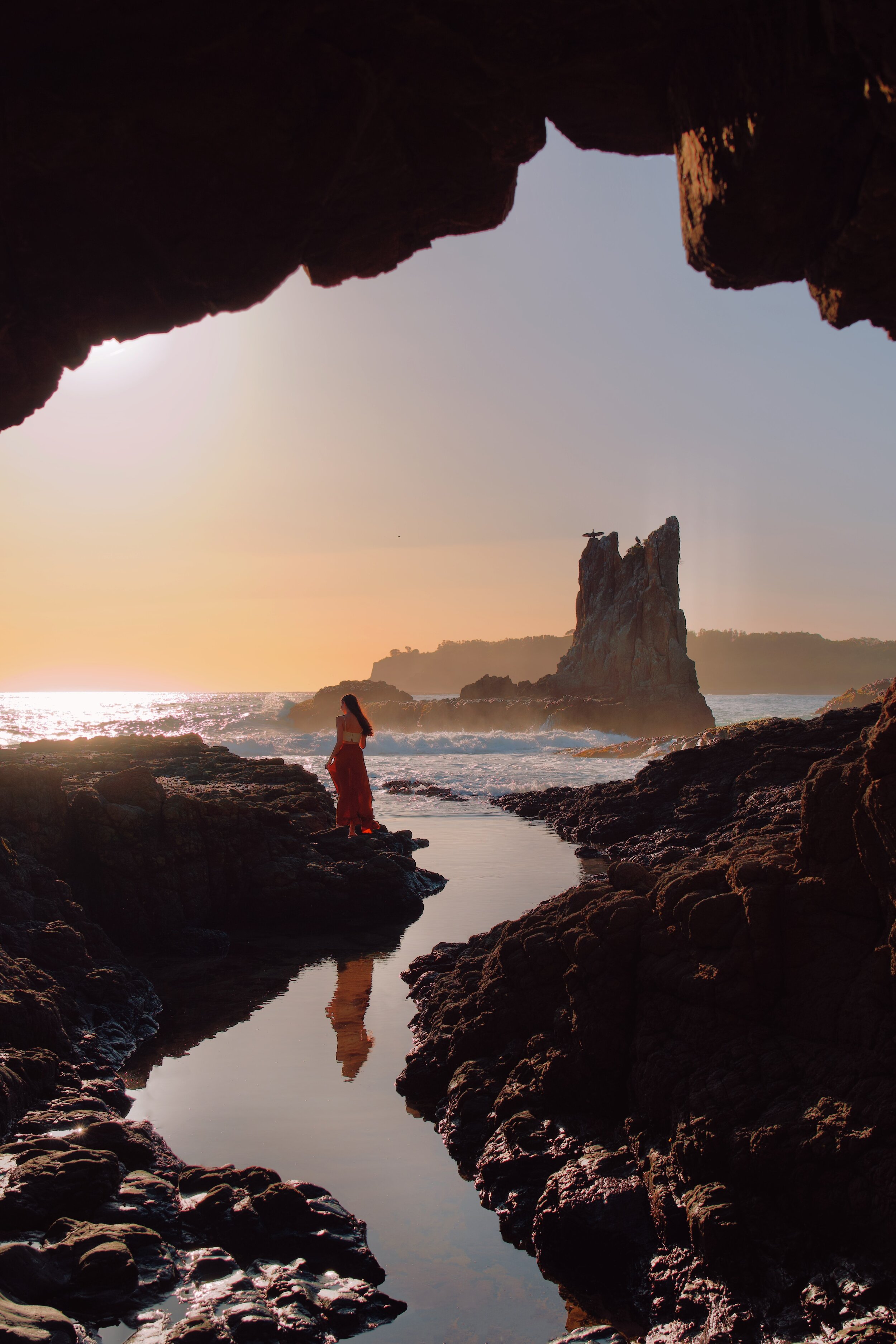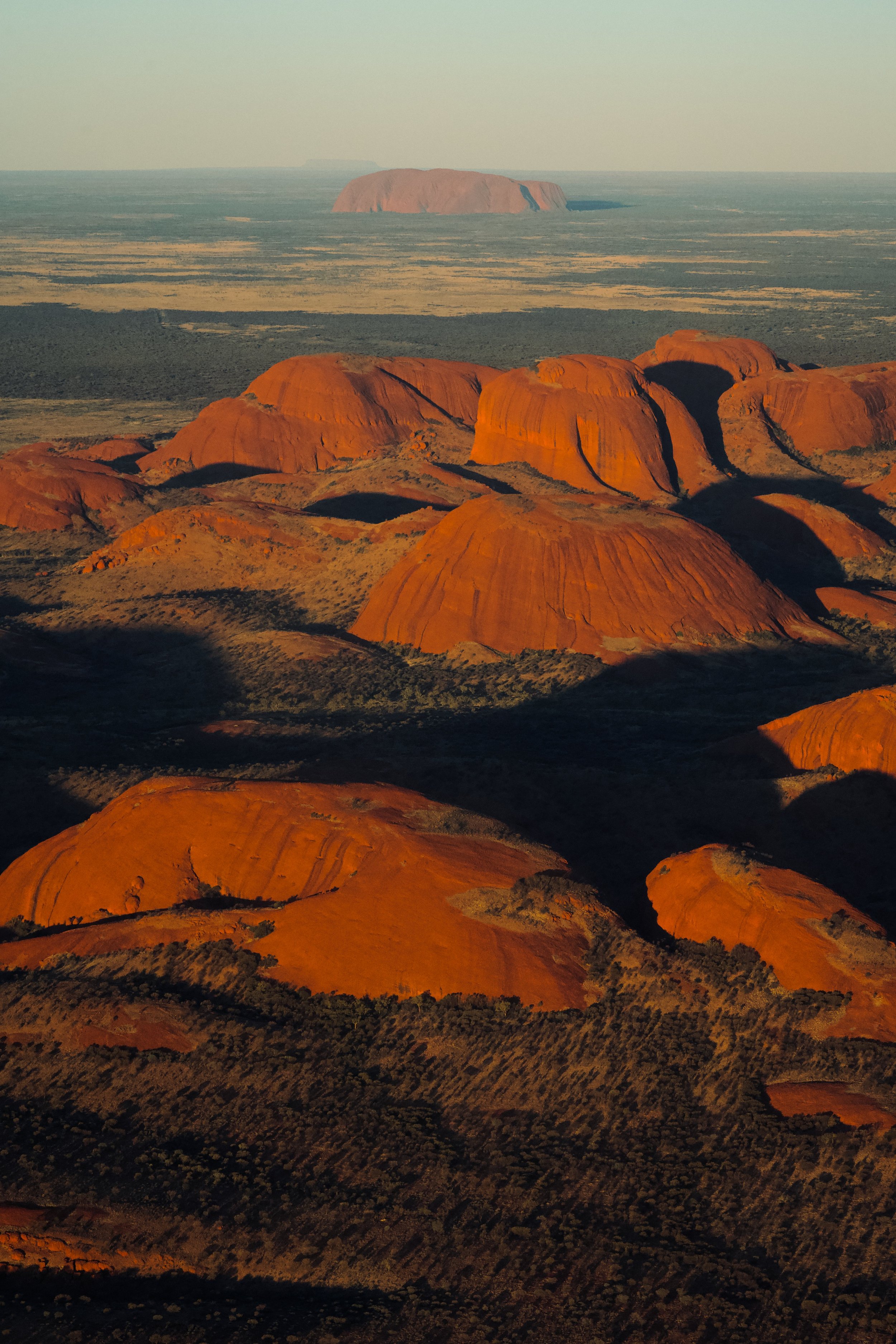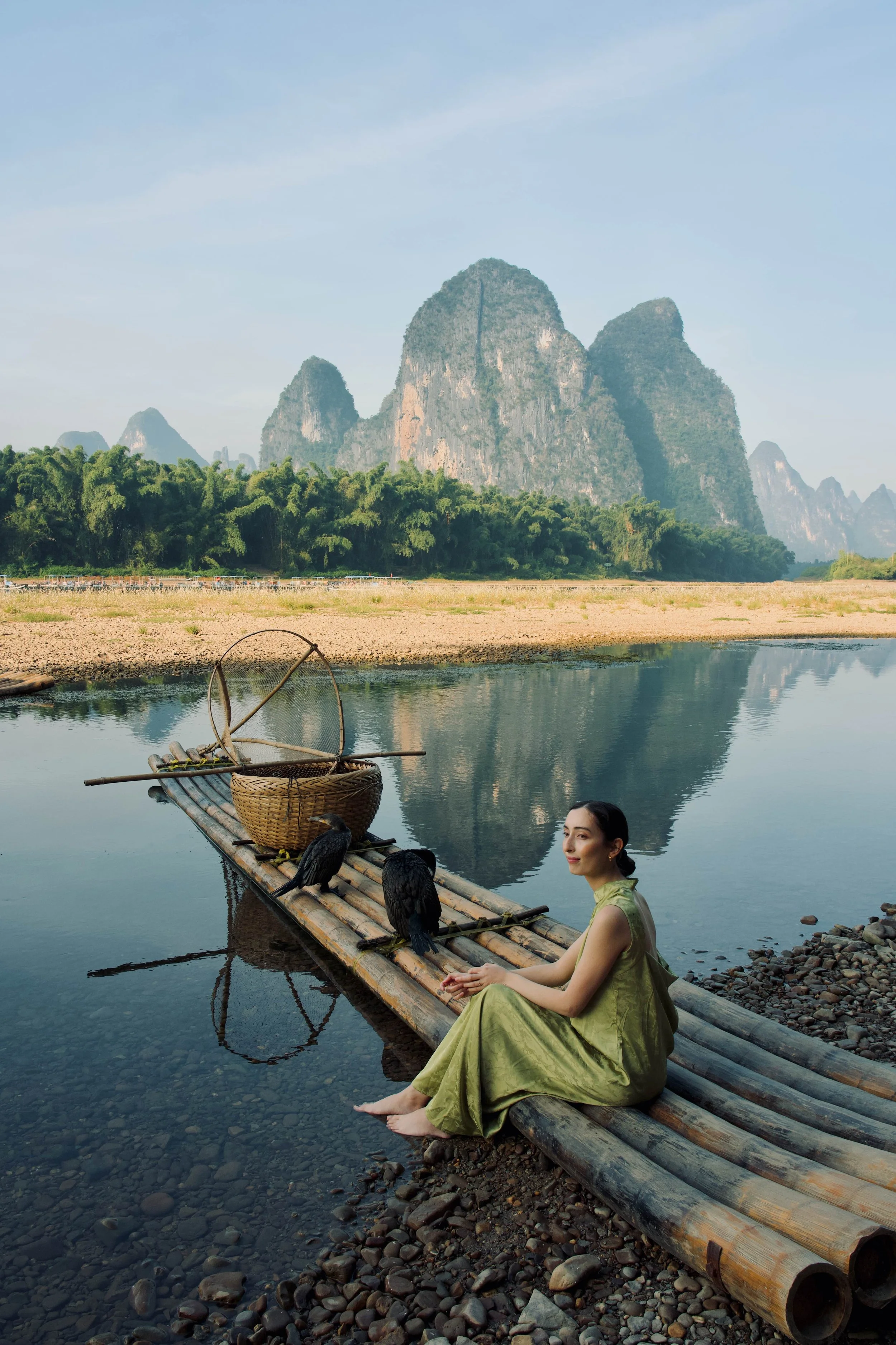A complete guide of things to do in Uluru-Kata Tjuta National Park
by ling and jace
Uluru-Kata Tjuta National Park is on Anangu land. We acknowledge and pay our respects to the Traditional Owners and celebrate the ongoing connection of Aboriginal people to the land and water of Australia.
home / back to australia
Full moon rise behind Uluru, shot from scenic flight
We spent a week under the super moon in Uluru-Kata Tjuta National Park. While we were there, we made a note that we sometimes feel the spin of the Earth—alive to the way shadows move as the sun rises and the moon sets.
Any trip to Uluru-Kata Tjuta National Park is so unique because the landscape is incredibly vast and open, with Uluru and Kata Tjuta on far sides of the horizon. Even though we were in the desert, with nothing in sight for tens of kilometres, we didn’t feel like we would run out of things to do.
We watched the colours change from sunrise to sunset, and filled each day with hikes and art and cultural tours. This is our complete guide of things to do in Uluru-Kata Tjuta National Park. In case you’re planning an itinerary or looking for things to do during a short trip, we’ve put all of the best trails, viewpoints and tour options in one place. You can watch our vlog from the trip here.
Super moon and Uluru, shot from sunset viewing area
CONTENTS
This post includes everything we did that made our visit so unique, and some experiences that we wished we had time for. We’ve separated it into two sections:
things to know before you visit Uluru-Kata Tjuta National Park, and
things to do when you get to Uluru-Kata Tjuta National Park.
We’ve included links within this post—click below to jump to each section.
THINGS TO KNOW BEFORE VISITING ULURU-KATA TJUTA NATIONAL PARK
THINGS TO DO IN ULURU-KATA TJUTA NATIONAL PARK
ART AND CULTURAL ACTIVITIES
Gallery of Central Australia (GoCA)
Bush yarns
Bush food experience
Didgeridoo workshop
Aboriginal painting classes
Arkani Theatre screenings
Guided garden tour
Sunset over Kata Tjuta, shot from scenic flight
Lake Amadeus, shot from scenic flight
Full moon in Uluru-Kata Tjuta National Park
THINGS TO KNOW BEFORE VISITING ULURU-KATA TJUTA NATIONAL PARK
ACCOMMODATION IN ULURU-KATA TJUTA NATIONAL PARK
The closest town to Uluru-Kata Tjuta National Park is Yulara, which is about 10 minutes’ drive from the entrance to the National Park. There’s only a handful of restaurants, cafes, souvenir shops, and a small IGA supermarket in town. All of the accommodation is part of the Aboriginal-owned Ayers Rock Resort enterprise:
Longitude 131° (luxury accommodation)
We stayed in Emu Walks Apartments as we prefer to be able to cook when we travel. Typically you can save money cooking your own meals, but food is also quite expensive in the local supermarket (at around 2-3 times what you’d ordinarily pay in other Australian states).
HOW TO GET TO AND FROM ULURU-KATA TJUTA NATIONAL PARK
The closest airport to Uluru-Kata Tjuta National Park is Ayers Rock Airport (also known as Connellan Airport), which is around 10 minutes’ drive from the town of Yulara.
If you want to continue on to other parts of the Northern Territory like Alice Springs or King’s Canyon, these shuttle services are available:
Uluru to Alice Springs (one-way) (around 5.5 hours)
Uluru to King’s Canyon (one-way) (around 4 hours)
HOW TO GET AROUND ULURU-KATA TJUTA NATIONAL PARK
TOURS
One of the easiest ways to get around Uluru-Kata Tjuta National Park is by joining good tours. The cost of car hire is high in this part of Australia, so tours can also end up being a more cost effective option during a short stay.
For unique tours around the whole area, we’d recommend checking out these options:
Package of 4 tours in Uluru-Kata Tjuta and King’s Canyon (choose a combination over three days)
Throughout this post, we’ve included a range of tours that we’d recommend for getting to each hike, lookout and experience that we’ve shared. We’ve also included a full list of tours—from sunrise to sunset, hiking, stargazing and scenic flights—at the very end.
View of Lake Amadeus, shot from scenic flight
CAR
We recommend hiring a car from the airport in Uluru-Kata Tjuta National Park. All of the roads are sealed, so it’s a good way to get around, and you’ll also have the flexibility to stop on the side of the road for photos (in permitted areas). We’ve included driving times from Yulara to the main attractions in the section below.
The only downside to hiring a car is the cost. There’s only one petrol station in Yulara and it’s expensive. Car rentals also typically impose a 100km/day driving “limit” for car hire in the Northern Territory, where you’ll be charged around 35 cents for each kilometre over the total limit. The limit is usually fine for the days you are driving to Uluru, but you’ll likely go over it on the days you are driving to Kata Tjuta. If you’re also driving to King’s Canyon and spending time in Watarrka National Park, you’re going to be well over that daily limit.
View of Kata Tjuta while driving
BUS
Alternatively, there is a hop-on hop-off bus that runs from each hotel in Yulara to various attractions in the Uluru-Kata Tjuta National Park. You can check the pricing and timetables in the links provided.
Camel on Lake Amadeus, shot from scenic flight
BEST TIME OF YEAR TO VISIT ULURU-KATA TJUTA NATIONAL PARK
Anangu recognise 5 seasons in Uluru-Kata Tjuta National Park. You can read about them here.
The better time of the year to visit Uluru-Kata Tjuta National Park is from April to September. It gets a bit cold in winter, but rarely rains and the weather is mostly clear. We visited in June, which is the peak season for visiting Uluru-Kata Tjuta National Park. It was great for clear skies and temperatures peaking in the low 20s°C.
You can still visit Uluru-Kata Tjuta National Park in the summer months, but it’s common for daily temperatures to be well over 36°C. When this happens, most of the trails are closed after a certain time in the morning, and it’s recommended that you aim to finish them before 11:00am to avoid the extremely harsh heat and sun. Some of the tours, like scenic flights in the middle of the day, may also be cancelled during the heat.
HOW LONG TO SPEND IN ULURU-KATA TJUTA NATIONAL PARK
You need time to take it all in at Uluru-Kata Tjuta National Park. It’s the kind of landscape that leaves you in wonder, even weeks after you’ve visited. With only 3 full days, we had so many things to do in Uluru-Kata Tjuta National Park. There are many hiking trails, sunrise and sunset lookouts, art and cultural activities, and tours in the area.
CULTURAL SENSITIVITY AND PHOTOGRAPHY
Uluru-Kata Tjuta National Park is an important cultural area for Anangu. There are a number of rock details and features in the National Park that are sacred to Anangu, and should only be viewed at their original location and by certain people. Taking photos, filming, or painting these details and features is not permitted. In these areas, visitors are still welcome to photograph close ups of people, flora and fauna, as long as you’re not photographing the rock details and features that hold the cultural significance for Anangu.
Culturally sensitive sites are quite easy to identify as there are often signs on site. All of the maps that the National Park tourism board provide also clearly show the culturally significant areas are as well. See this page on their website and the brochure linked there.
In the sections below, we’ve made a note where the attractions have culturally significant sites that should not be photographed. It includes the entire north-eastern face of Uluru and many parts of the hikes in Kata Tjuta.
ENTRY PASSES TO ULURU-KATA TJUTA NATIONAL PARK
Entry passes to the National Park cost $38 per person and are valid for 3 days. At the gate, park rangers can extend the passes to 5 days (free of charge) if you’ve planned for two more days in the park.
You can purchase entry passes online, or at the gate on the day.
Lake Amadeus, shot from scenic flight
THINGS TO DO IN ULURU-KATA TJUTA NATIONAL PARK
Watch our vlog from the trip here:
WALKS IN ULURU-KATA TJUTA NATIONAL PARK
We started most mornings watching the sunrise over Uluru and then hiking before it got too high. For all of these hikes, make sure you have plenty of water and sun protection (hats and SPF 50+ sunscreen at a minimum). For the longer hikes, we recommend taking at least 1.5L of water per person, but there are some watering points along the way.
ULURU WALKS
ULURU BASE WALK
Distance: 10.6km
Time: 3-4hrs
Difficulty: easy, terrain is mostly flat and cleared dirt, and large sections will be in the shade due to the position of the sun on Uluru
Type: loop circuit
Cultural sensitivity: yes, in certain sections (identified by signs) and along the entire north-eastern face.
Uluru base walk tour: this is the best small group tour that we could find which includes sunrise over Uluru and breakfast before hiking around the base.
Alternatively, this tour covers cultural sites around the base of Uluru and Kata Tjuta (with driving and short trails instead of the full Uluru base walk).
Uluru-Kata Tjuta full-day hiking and sunset tour: if you’re looking for a longer tour which includes the base walk, we’d recommend this one as it covers more of the national park. It follows two hikes (one in Kata Tjuta and then the base walk) and ends with a sunset bbq at Uluru.
The Uluru base walk starts at the Mala carpark and loops around Uluru in its entirety. You really get a sense of how big Uluru is by being underneath it, and pass a lot of cultural and historical artefacts along the way. There are fresh water taps and bathrooms at the Mala carpark and the Kuniya Piti checkpoint which is roughly halfway into the walk.
Ling at the base of Uluru
The base walk is also separated into different sections which can all be done individually if you aren’t able to complete the entire circuit at once. These are:
MALA WALK TO KANTJU GORGE
Distance: 2km in and out return
Time: 1hr
Cultural sensitivity: yes, in certain sections (identified by signs)
NORTH-EAST FACE WALK TO KUNIYA PITI
Distance: 4-5km one way
Time: 1.5-2hrs
Cultural sensitivity: yes, the entire walk
KUNIYA TO MUTITJULU WATERHOLE WALK
Distance: 1km in and out return
Time: 30-45mins
Cultural sensitivity: no
LUNGKATA TO KUNIYA PITI WALK
Distance: 4km one way
Time: 1.5-2hrs
Cultural sensitivity: yes, in certain sections (identified by signs)
LIRU WALK
Distance: 4km
Time: 1.5-2hrs
Difficulty: easy to moderate
Type: one way
Cultural sensitivity: no
This walk connects the Cultural Centre to the Mala carpark. It has fantastic views of the south-western face of Uluru for the duration of the walk.
KATA TJUTA WALKS
WALPA GORGE WALK (KATA TJUTA)
Distance: 2.6km in and out return
Time: 1hr
Difficulty: easy
Cultural sensitivity: yes, Anangu ask that you keep both sides of the gorge in frame when you film, paint, draw or photograph Walpa Gorge and that you walk quietly through the area.
View from the start of the Walpa Gorge walk at sunset
This is an easy and beautiful in and out trail to a view of a gorge. Around sunset, the colours of the rock valley walls glow. a stunning red, making it a beautiful spot to enjoy the end of the day.
Walpa Gorge short tour and hike: the Walpa Gorge hike is best in the afternoon, when the sun is directly on the rocks. This tour is a good short option which includes hotel transfer to the gorge.
View at the end of the Walpa Gorge walk
VALLEY OF THE WINDS CIRCUIT WALK (KATA TJUTA)
Distance: 7.4km loop
Time: 3-4hrs
Difficulty: mostly moderate, with some steep sections of incline
Terrain is a mix of clear dirt and rocky paths
Type: circuit loop
Cultural sensitivity: yes, Anangu ask that you do not take any photos of the rock in the valley while you are on the walk.
Sunrise and Valley of the Winds tour: if you want to hike through the Valley of the Winds, this tour includes transport, sunrise lookout over Kata Tjuta and breakfast before a guided hike through the valley.
Karingana Lookout (photos permitted), Valley of the Winds
The Valley of the Winds circuit is one of the most unforgettable walks in all of Uluru-Kata Tjuta National Park. The trail passes between some of the domes that make up the Kata Tjuta rock structure itself.
Indigenous elders ask visitors not to photograph most parts of this trail as it winds through sacred areas. Photos are permitted at Karingana Lookout, which is where this incredible view of the valley is taken from. Photos are also permitted of flora, fauna and people (close up) that block the details of the rocks.
There are 2 lookouts along the way where you can optionally return from if you don’t want to complete the full circuit:
Karu Lookout (about 1hr, 2.2km return)
Karingana Lookout (about 2.5hrs, 5.4km return)
We highly recommend you conitnue to Karingana Lookout, as it gives the most spectacular view of a hidden landscape in the distance between the dome walls.
Always carry plenty of water and sun protection, but note there are 2 points where you can refill water on the circuit too. During the warmer months, it’s highly recommended that you finish before 11am as large sections of the walk is exposed to the sun.
Sunrise from the Kata Tjuta sunrise dune viewing area before Valley of the Winds hike
THE BEST SUNRISE AND SUNSET SPOTS IN ULURU-KATA TJUTA NATIONAL PARK
We caught the most surreal sunrises and sunsets in Uluru-Kata Tjuta National Park because our trip coincided with a super moon. The full moon was at the closest point to Earth in its orbit, and we got to see it rise in a deep orange glow behind the rock itself.
BEST SUNRISE AND SUNSET SPOTS FOR ULURU
There are two main lookouts for sunrise and sunset over Uluru:
Talinguru Nyakunytjaku (Uluru sunrise viewing area)
Uluru sunset viewing area (split into separate areas for cars and coaches)
Full moon and Uluru, shot from sunset viewing area (car park)
Sunrise behind Uluru shot from Kata Tjuta dune viewing area
Uluru and Kata Tjuta, shot from scenic flight
Sunrise (Talinguru Nyakunytjaku)
Anywhere at Talinguru Nyakunytjaku (the sunrise viewing area) is fantastic for watching the sun rise over Uluru, but it also contains 2 short, wheelchair accessible walks to viewing platforms:
Minymaku Walk (Women’s Walk)
Watiku Walk (Men’s Walk)
The Minymaku Walk (Women’s Walk) is about a 1km loop which teaches you about women’s business, such as processing bush foods and games for children. The Watiku Walk (Men’s Walk) is about a 1.5km loop walk which teaches you about men’s business, such as tool making and hunting.
If you’re driving, it’s about 25 minutes’ drive from Yulara, and we would recommend arriving 15-20 minutes before sunrise to beat the crowds.
Alternatively, these are some of best tours that you can take to the sunrise viewing area:
Uluru sunrise view and picnic breakfast: this morning cultural tour starts with a picnic breakfast at one of the most scenic sunrise viewing points.
Uluru to Kata Tjuta at sunrise: if you want to go a bit further into the national park, this tour takes you to Kata Tjuta at sunrise. From there, there’s really unique view of Uluru in the distance, with the red glow from the sun covering the entire horizon.
Uluru sunrise base walk: this small group tour starts before sunrise to get to the most beautiful area to watch the colours change at the base of Uluru.
SUNSET (ULURU SUNSET VIEWING AREA)
The Uluru sunset viewing area is easily accessible, about 15 minutes’ drive from Yulara. It gets extremely busy very early, so we recommend arriving about 30-45 minutes before sunset. It’s a great spot to set up for an hour with some food, and watch the colours of Uluru change as the sun sets over the rock.
There’s a separate viewing area for bus tours, some of which include:
Uluru sunset and gourmet bbq: a unique sunset and stargazing experience in Uluru. It starts at a sunset viewing area with refreshments, before heading to a secluded outdoor dining area with a bbq dinner.
The Uluru and Kata Tjuta base walk tour and Uluru cultural sites tour also finish at the viewing area for sunset.
BEST SUNRISE AND SUNSET SPOTS FOR KATA TJUTA
Kata Tjuta was the most dominant formation on the horizon for us—we saw it continuously throughout the day, even while driving. The highest point reaches over 500 metres, and we started many mornings watching the sunrise over the domes. There are two main areas to watch the sunrise and sunset over Kata Tjuta:
Kata Tjuta sunrise dune viewing area
Kata Tjuta sunset viewing spot
Sunrise from the Kata Tjuta sunrise dune viewing area
KATA TJUTA SUNRISE DUNE VIEWING AREA
The Kata Tjuta sunrise dune viewing area is about 30 minutes’ drive from Yulara. There’s a short, wheelchair accessible walk to the viewing platforms, where you can also see the silhouette of Uluru glowing orange in the distance.
There’s an ancient and vast desert landscape between the viewing platforms and Kata Tjuta, which gives the scene a surreal, jurassic feeling. Another 15 minutes’ drive down the road gets you to the start of the Valley of the Winds and Walpa Gorge walks.
Kata Tjuta sunrise tour: this is a great way to have breakfast during the sunrise over Kata Tjuta.
Sunrise and Valley of the Winds Tour: if you want to add a hike through the Valley of the Winds, this tour also takes you to the hiking trail after sunrise and breakfast.
KATA TJUTA SUNSET VIEWING SPOT
The Kata Tjuta sunset viewing spot is about 45 minutes’ drive from Yulura, the furthest you have to drive to get anywhere in the national park. It’s so close to the Kata Tjuta rocks that you’ll almost be right under it, making sunset an incredibly enriching experience.
This spot is less popular than the others, but we still recommend arriving about 30 minutes before the sun sets so you can relax and experience all of the changing colours over Kata Tjuta. Note: this is also the only spot in the Kata Tjuta side of the national park with bathrooms.
Kata Tjuta sunset tour: we saw this tour setting up for sunset while we were in Kata Tjuta at one of the most beautiful vantage points. It includes chilled Australian wines and canapés.
BEST TOURS IN ULURU-KATA TJUTA NATIONAL PARK
In case you’re planning your itinerary or looking for things to do during a short trip to Uluru-Kata Tjuta National Park, we’ve put all of the best tour options in one place. We’d recommend taking them as a convenient way to get around, especially given the cost of car hire. Some tours can even get you to areas that can’t otherwise be accessed, like Lake Amadeus on a scenic flight.
We have joined some of these tours or seen them operating, and have also vetted them through reviews on GetYourGuide and Viator. We’ve mentioned the specific tours that usually book out in advance, but in general note that there are over 6,000 visitors Uluru-Kata Tjuta National Park each day in peak seasons, so it’s always helpful to plan ahead.
MULTI-DAY TOURS
Package of 4 tours in Uluru-Kata Tjuta and King’s Canyon: this is the most convenient way to book the highlights listed in this post, as you can select four half-day tours and take them any time during a three-day stay. This tour includes all entrance fees and different options to choose from (including option to take a half-day trip to King’s Canyon to add the rim walk to your itinerary).
6 days in the red centre, 2 nights camping under the stars: this tour comes with really high reviews, and runs from Uluru-Kata Tjuta to Alice Springs via King’s Canyon and the West MacDonnell Ranges. It includes two nights of camping under the stars, our most recommended hikes in the area, and some meals.
Uluru at sunset, with the full moon rising behind, shot from scenic flight
SUNRISE TOURS
Uluru sunrise view and picnic breakfast: this morning cultural tour starts with a picnic breakfast at one of the most scenic sunrise viewing points over Uluru.
Uluru to Kata Tjuta at sunrise: if you want to go a bit further into the national park, this tour takes you to Kata Tjuta at sunrise. From there, you get a really unique view of Uluru in the distance, with the red glow of the sun covering the entire horizon.
Field of Lights at sunrise: the Field of Lights is booked out months in advance at sunset, but this tour runs during sunrise for an alternative experience of the art installation.
Sunrise from the Kata Tjuta dune sunrise viewing area
SUNSET TOURS
Uluru and Kata Tjuta base walk to sunset: this tour covers the base walk of Uluru and a hike in Kata Tjuta during the day, then ends with sunset from a viewing area. Alternatively, this tour covers cultural sites by driving around the base of Uluru and Kata Tjuta (and short walks instead of the full base walk).
Uluru sunset and gourmet bbq: this is a unique experience to see the sunset and stars over Uluru. It starts at a sunset viewing area with refreshments, before heading to a secluded outdoor dining set up with a bbq dinner.
Uluru and Kata Tjuta scenic flight at sunset: in addition to the scenic flight tours we’ve listed below, this one specifically runs at sunset for the most vibrant colours.
Sunset from Uluru sunset viewing area
HIKING TOURS
Uluru base walk: this is the best small group tour that we could find which includes transport, sunrise over Uluru and breakfast before hiking around the base.
Uluru-Kata Tjuta full-day hiking and sunset tour: if you’re looking for a longer tour which includes the base walk, we’d recommend this one as it covers more of the national park. It includes two hikes (one in Kata Tjuta and then the base walk) and ends with sunset over Uluru.
Kata Tjuta sunrise and Valley of the Winds Tour: this tour includes guided hike through the Valley of the Winds (our favourite hike in the national park) after breakfast at sunrise.
Walpa Gorge trail tour: the Walpa Gorge hike is best in the afternoon, when the sun is directly on the rocks. This tour is a good short option which includes transport to the gorge.
Sunrise over Kata Tjuta from Kata Tjuta dune viewing area
SCENIC FLIGHTS OVER ULURU, KATA TJUTA AND LAKE AMADEUS
At the very end of our trip, we booked a scenic flight over Lake Amadeus, Uluru and Kata Tjuta. Across the plain, we could see each natural formation in Uluru-Kata Tjuta National Park lining up—from desert and salt flats to King’s Canyon, to Kata Tjuta and Uluru under the full moon. It was unbelievable to see everything glowing red from above.
Scenic flight over Uluru: if you want to see Uluru from above, this is one of the more affordable, shorter tours.
Scenic flight from Uluru to Kata Tjuta: Kata Tjuta is around 50 kilometres away from Uluru and is definitely worth seeing from above, reaching around 500 metres at its highest peak.
Scenic flight over Uluru, Kata Tjuta and Lake Amadeus: out of all scenic flight options, we’d recommend one that passes over Lake Amadeus. It is a huge salt lake to the north of Uluru, which isn’t accessible on the ground or by car (so a scenic flight is the only way to get there). The pastel textures are otherworldly and, if anything, reminded us of images of storms on the surface of Jupiter. You can reach Lake Amadeus by helicopter here or small plane here (a slightly cheaper option).
Scenic flight to King’s Canyon: for the most epic scenic flight, this option is a 2-hour tour all the way from Uluru and Kata Tjuta to King’s Canyon. It also passes over Lake Amadeus, so you would be seeing absolutely everything by air.
ASTRO TOURS
As we drove out of Uluru-Kata Tjuta National Park in the dark after sunset, we thought that it would be the perfect place for astrophotography. There are no lights in the national park at all, and to see the milky way stretch out over Uluru would be surreal.
The national park does have closing times that differ depending on the time of the year, which means that to catch the stars you either have to stay in the park for a few hours after sunset, or book an astro tour which costs about $55/pp and last about an hour.
Uluru dinner under the stars: if you want a unique dining experience under the stars, this bbq dinner is available in Uluru after dark and includes star gazing with a local guide.
Full moon rise in Uluru
FIELD OF LIGHTS
The Field of Lights is a solar-powered, hand-crafted art installation of 50,000 lights beside Uluru. The Field of Lights is always booked out months in advance, so we missed out on seeing it on this trip.
This tour offers a unique experience at sunrise, where you can also see from Uluru and the Field of Lights to Kata Tjuta at the very start of the day:
Sunrise behind Uluru shot from Kata Tjuta dune viewing area
SOUNDS OF SILENCE
The Sounds of Silence is a high end dining experience. It includes dinner at the top of a dune, overlooking Uluru-Kata Tjuta National Park. Tickets can be booked in advance through Ayers Rock Resort.
Super moon rise behind Uluru, shot from sunset viewing area
ART AND CULTURAL ACTIVITIES
There are many free cultural activities around Yulara during the day. The Ayers Rock Resort website has more information about each of these, and they’re a great way to learn about the area around Uluru-Kata Tjuta National Park and Anangu culture during the day.
These experiences include:
Gallery of Central Australia (GoCA)
Bush yarns
Bush food experience
Didgeridoo workshop
Aboriginal painting classes
Arkani Theatre screenings
Guided garden walks
Red centre shot from scenic flight over Uluru and Kata Tjuta
RECENT POSTS
PIN IT
Find us on Instagram

